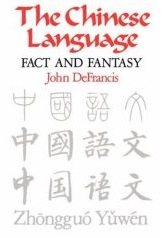The Chinese Language: Fact and Fanstasy: Difference between revisions
From Cibernética Americana
Jump to navigationJump to search
No edit summary |
No edit summary |
||
| Line 1: | Line 1: | ||
<div align=right> | <div align=right> | ||
{{Infobox Book | {{Infobox Book | ||
| Line 27: | Line 24: | ||
}} | }} | ||
</div> | </div> | ||
== Local Lede == | |||
{{TOCleft} | |||
[[:en:The Chinese Language: Fact and Fantasy]] | |||
'''''The Chinese Language: Fact and Fantasy''''' is a book written by [[John DeFrancis]], published in 1984 by University of Hawaii Press. The book describes some of the concepts underlying the [[Chinese language]] and [[writing system]], and gives the author's position on a number of ideas about the language. | '''''The Chinese Language: Fact and Fantasy''''' is a book written by [[John DeFrancis]], published in 1984 by University of Hawaii Press. The book describes some of the concepts underlying the [[Chinese language]] and [[writing system]], and gives the author's position on a number of ideas about the language. | ||
Revision as of 07:06, 29 January 2010
| The Chinese Language | |
|---|---|
 Cover of the paperback edition | |
| Author | John DeFrancis |
| Language | English |
| Genre(s) | Nonfiction |
| Publisher | University of Hawai'i Press |
| Publication date | 1984 |
| Media type | Hardcover, Paperback |
| Pages | 330 |
| ISBN | ISBN 0-8284-0866-5, ISBN 0-8248-1068-6 (paperback) |
Local Lede
{{TOCleft} en:The Chinese Language: Fact and Fantasy
The Chinese Language: Fact and Fantasy is a book written by John DeFrancis, published in 1984 by University of Hawaii Press. The book describes some of the concepts underlying the Chinese language and writing system, and gives the author's position on a number of ideas about the language.
Main points
- There is not a unique "Chinese language". There is a group of related ways of speaking, which some may call dialects, others call topolects (a calque of Chinese 方言, fāngyán; DeFrancis uses the term "regionalects"), and still others would regard as separate languages, many of which are not mutually intelligible. One such variant, based on the speech of the Beijing area, has been chosen as the standard language in the People's Republic of China, and is now known as "Putonghua", or common language.
- The Chinese writing system has a heavy phonological basis, shown in the phonetic elements common in more than 95% of Chinese characters. Unfortunately they are missing from many common characters, and were removed from numerous "simplified" characters, causing many scholars to miss the point that they are a necessary resource for Chinese readers. It is not a brilliant ideographic script; it is a poor phonetic script.
- Although there are characters in the Chinese writing system that visually represent concepts, such as 一 二 三 for one, two, and three, Chinese writing is not ideographic in the sense that the symbols represent ideas divorced from language. There can be no such thing as a completely ideographic writing system, where there would be symbols to stand for all possible individual concepts and where morphemes or phonemes would play no significant role in writing individual words. For instance, most Chinese words are written as phono-semantic compounds that include a non-ideographic, phonetic element.
- The Chinese script, with its huge number of characters, its complexity and its irregularities, is harmful to the literacy improvement efforts of the Chinese society, and needs to be replaced by a more efficient writing system if China is to achieve the benefits of modernization.
Six myths
A good portion of the book is devoted to debunking what DeFrancis calls the "six myths" of Chinese characters. The myths are:
- The Ideographic Myth: Chinese characters represent ideas instead of sounds.
- The Universality Myth: Chinese characters enable speakers of mutually unintelligible languages to read each other's writing. (Also, to the extent this is possible, this is due to a special property that only Chinese characters have.) Furthermore, Chinese from thousands of years ago is immediately readable by any literate Chinese today.
- The Emulatability Myth: The nature of Chinese characters can be copied to create a universal script, or to help people with learning disabilities learn to read.
- The Monosyllabic Myth: All words in Chinese are one syllable long. Alternatively, any syllable found in a Chinese dictionary can stand alone as a word.
- The Indispensability Myth: Chinese characters are necessary to represent Chinese.
- The Successfulness Myth: Chinese characters are responsible for a high level of literacy in East Asian countries. (A weaker version of this myth is simply that despite the flaws of Chinese characters, East Asian countries still have a high level of literacy.)
All of these are dealt with in separate chapters, at length, in the book.